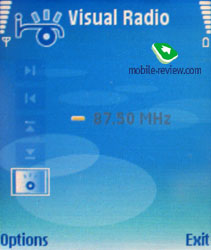|
|
Comparison of music smartphones Nokia N91 and Sony Ericsson W950i
Last year’s spring saw release of a unique article over at Mobile-Review.com – comparison of the latest and greatest music phones. That editorial prompted a flurry, and our readers were eagerly waiting for the next installment, which was to be comparison of music smartphones Nokia N91, SonyEricsson W950i and Samsung i300. As they say, the time has come, and finally we are delivering on our promise in this very article. However, it will be a duel between two smartphones – Samsung’s smartphone is a rare guest in retail stores, thus we don’t see it fit enough for this comparison (another point is banal obsolescence). As for the participants that are still in, either of these handsets is hot, especially against the backdrop of ever-falling prices. Let us remind you: the sales of Nokia N91 officially commenced at 800 USD, whereas these days you can get it for about 500 (since spring of 2006), almost the same pricing curve holds true for the Sony Ericsson-branded offering – 700 USD in the beginning, that ultimately got down to 500-550 USD per unit. While Nokia’s device has already managed to get a successor in the form of Nokia N91 8G, it is still the company’s flagship music-minded solution, that is still far from being replaced. Though, the same goes for the W950i, which is top of the SE’s Walkman line, whose place might soon be inherited by an edition sporting more storage space onboard.
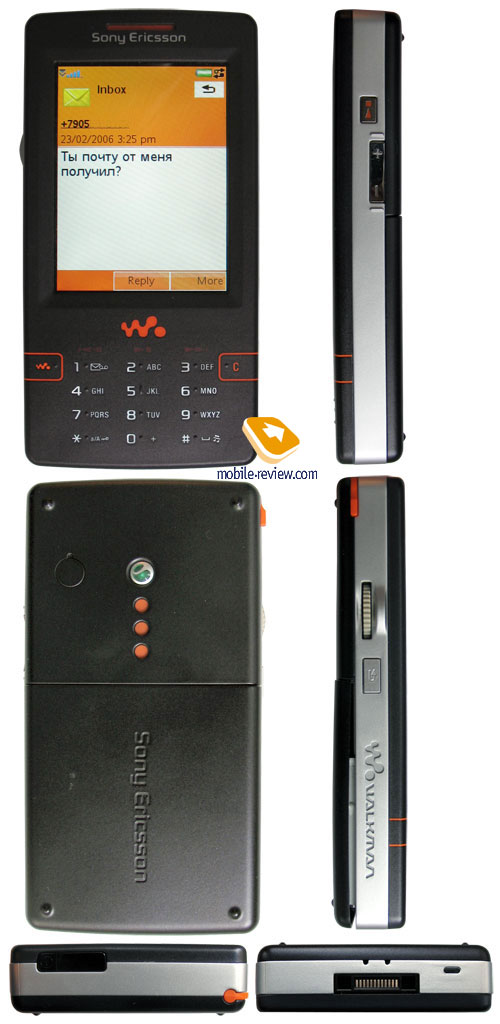
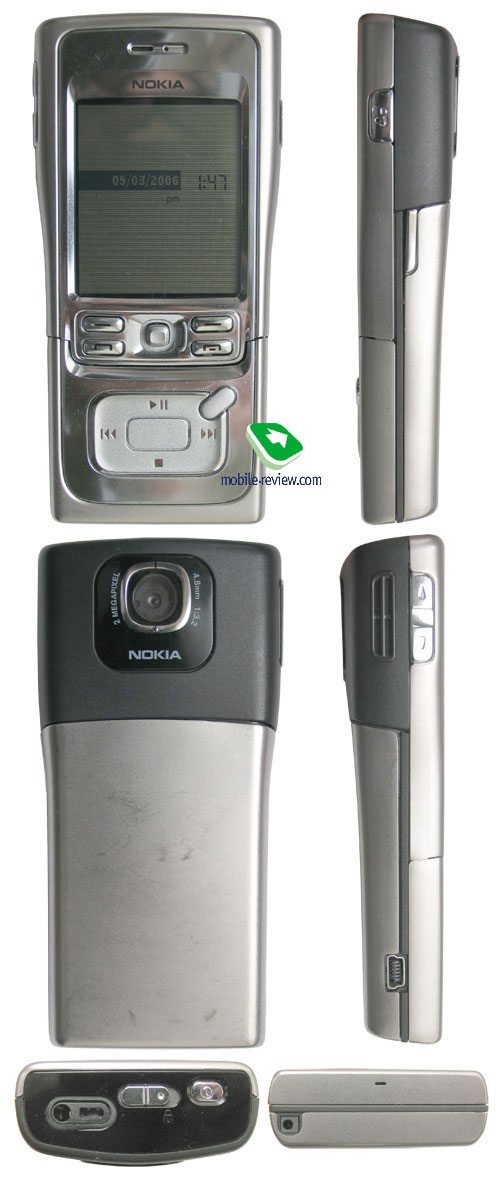
It is obvious, that the ways these handsets are positioned are very resembling, yet they aren’t twin in this sense – the similarity comes down to the area they deal with, which is, of course, music. This comparison is the result of very long usage sessions I had with both smartphones – about 2 months for the W950i and 5 months for the N91. To make our final judgment more competent, I involved into testing volunteers from among friends, and you shouldn’t be skeptic about this – subjective feelings were taken out of this affair, as everyone who was allowed to try these phones out had to do that blindfold. Over and above those five men are not zealous gadget aficionados and their marks come to “love it – hate it”, without special preferences for brand, operating system etc.
The structure of this comparison will be different from the previous article – here we are putting face to face only two devices, albeit the segment’s best offerings. So instead of giving them grades, we will rate them with “+” and “-“, that will be summed up, allowing us to figure out which device has more of positive traits and which one, on the contrary, falls flat. I shall mention this in the very beginning – this article is mainly aimed at people who are now facing the dilemma which one to go for, I do hope that reading this article will provide you with compelling arguments. That’s all I wanted to say in the prologue, now on to the review.


Sales package
Since both devices are music-heavy flagships in the respective companies’ line-ups, they come boxed with, let’s call it, enhanced selection of extras. If we are talking about Nokia N91, then its package includes:
- Music Headset HS -28 stereo-headset (with remote control)
- Cradle
- 970 mAh battery (BL-5C)
- Travel charger (AC-4)
- USB data cable (DKE-2)
- Nokia Charger Adapter Cable CA-44
- CD-ROM with software
- User Guide
In its turn, the W950i comes with:
- HPM-82 stereo-headset (with remote control)
- Battery
- Charger
- USB data cable
- Carrying pouch
- CD-ROM with software
- User Guide
Apparently, in terms of box contents it is a draw, since for either of the devices the sales package is rich, even though there are some differences: the cradle the N91 comes boxed with and the W950i does not, but in return it shows off a carrying pouch. At that you can buy a Sony Ericsson cradle on your own – be it a solution with or without speakers.


All in all I give both proposals a “+” for the sales package without a slightest hint of hesitation – put the gadgets out of the box the user gets everything he needs to start using the handsets outright.
Extra music accessories
This is where Sony Ericsson’s model is far ahead of its vis-a-vis, as you can keep upgrading your device until you run out of money. Now judge: the company’s range offers three speakers-armed cradles (models MDS-60, MDS-70, MPS-60) a cradle with remote control MRC-60, a couple of wired headsets housed in various form-factors, audio cables, FM-transmitter, Bluetooth-receiver, should you want it, you can also buy a watch for remote management of music playback.
Among Nokia’s accessories you won’t find such wide selection of widgets – for the N91 we can purchase only speakers by other manufacturers (thanks to the standard jack), while the announced models haven’t made it to retail networks yet, the same goes for wired headsets for this handset.
I’m most positive that many will deem this an unimportant parameter; nevertheless the ability to purchase extra accessories for the device often enables extending its lifetime in the user’s pocket, getting new experiences and bumping up the functionality. That is why the W950i earns a “+” for extra native accessories, while the N91 ends up with a “-“.
Bluetooth stereo-headset support
Nokia N91 doesn’t support A2DP profile, whereas the W950i does. Perhaps, we could wind up this chapter at this very point, but I would like to say a few more words on some interesting things. Why they didn’t build the A2DP in the N91 – we can have only wild guesses. Absence of the A2DP starts looking even odder, when we check out how many stereo-headsets are offered by Nokia; to be precise, there are four of them, on top of that many of these were released prior to the N91’s launch. Sony Ericsson proposes only one gadget, model HBH DS-970 coming from the Walkman accessories range, which has nothing against working with the W950i at full capacity (unlike some other models) – by this we mean sound quality, as well as dedicated keys and information shown on the headset’s display.

We could keep harping about whether this functionality is a must or not for quite a while, but if you have ever used the DS-970 paired up with the W950i, then you have the idea of how convenient this combination is and don’t need to be persuaded about the necessity of the A2DP in a music-tailored device. My point of view – this profile is very essential and it inclusion into Nokia N91 8 Gb is consistent and justified.
Sony Ericsson W950i receives another “+” for A2DP and Nokia N91 – a “-“ for not having this.
Remote control
Both smartphones allow for remote management via remote controls – Nokia N91 comes boxed with the HS-28, while W950i – the HPM-82. Subjectively, and the focus-group proves that, the remote found in the N91’s sales package is handier to work with; the following aspects were pointed out as strengths:
- the HS-28 features a clothing clip on the casing, which is far more pleasant than a small cord-mounted clip on the HPM-82.
- the HS-28 sports more easy-to-use button, which are in fact arranged in an adequately sized joystick that provides decent soft clicks, whereas in the HPM-82 are somewhat less handy. What is more a stand-alone pick up and key lock buttons are missing, even though these tiny things may really save your day sometimes.
- while managing the handset and simultaneously pressing keys on the HPM-82, the phone responds with a slight delay, which is not particularly pleasant.
- Both remotes retain 3,5 mm jack for using own headphones, but this solution is not pretty convenient, taking account of the cord’s total length (50-60 cm of the earphones wire and almost the same length of the remote’s cord).


It is quite odd that Sony Ericsson has come up with such a controversial accessory in light of the fact the company has a knack for making such accessories. Undoubtedly it sports an eye-candy design, but its functionality is what we have gripes with, at the same time the HS-28 is made in way to provide maximum convenience when handling the handset remotely. It may happen, though, that Sony Ericsson’s line up will get a newcomer in the form of a more suitable solution, maybe armed with an LCD display, and this accessory will also be compatible with the W950i.


For the remote control and its ease-of-use, the N91 scores a “+” and the SE W950i – a “-“.
Design
This parameter is especially challenging to rate – taste actually do differ and everybody knows that. In favor of the N91 are metal casing, a certain bond with the once-famous Nokia 8850 (due to having slide-out keypad cover) and, naturally, the brand. Add to this an interesting advertising campaign as well. On the other hand, the W950i boasts a much more pocketable and lightweight casing, Walkman brand and eye-catching looks. The advertising campaign for this device was initiated not when the sales had begun, at that it has never been promoted separately, being a part of the new concept where the company’s logo replaced a heart. A draw? Not at all. The focus-group was quite unanimous, giving four votes to the N91 and one to the W950i’s design, in spite of all the abovementioned arguments. The upside is as follows: the Walkman’s casing looks too unpretentious, especially when compared to the N91. Had I counted my vote for three, it would an even score, though we make no allowances, the N91 comes out with a “+” and the W950i with a “-“.




Weight, size
The N91 weighs in at 164 grams and measures 113.1x55.2x22 mm, while the W950i’s figures are 112 grams and 106x54x15 mm respectively. The Sony Ericsson-branded device weights considerably less, has a slimmed-down casing and feels much nicer in day-to-day usage, at least because in summer dragging the N91 along is not very convenient (even though many carry their devices in bags or purses, there are some users that just throw phones into pockets). For this very attraction the focus-group (4 against 1) gave the W950i a “+” and a negative mark to the N91.
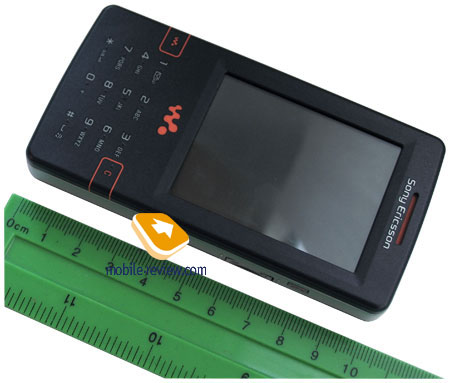

Personally, I can’t fully agree with such treatment of the N91, as in its case the consumer can literally feel what he gets for this much money: metal and size – this smartphone can be noted from far away.
Ergonomics, controls
In this paragraph we are going to touch device management with the help of the buttons found on the casing, more details on controls of either of the handsets faced off here can be found in respective reviews. In short, Nokia N91 has all its controls grouped on the flip, where the Play/Stop and rewind/fast forward buttons are placed, while the volume rocker is positioned more towards the top of the right-hand side. Entering the music library, managing tracks – all this can be done with the help of the joystick and the functional keys mounted right beneath the display. In reality you spend almost no time on getting used to it thanks to the proper layout of controls, so that in fact you can handle the device using your thumb’s tip alone. The same thing was highlighted by the focus-group members.

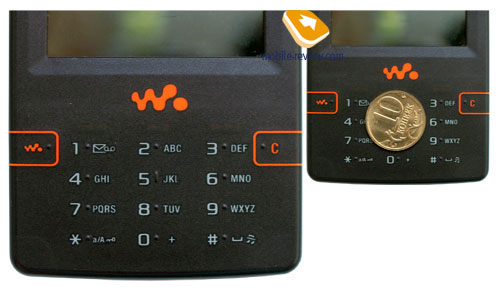
However the W950i’s device management department is not all sunshine and rainbows – dedicated keys are scattered all over the surface in a quite illogical pattern. Take a look for yourself: the fascia houses rewind, fast forward, Play/Stop and player shortcut buttons. The right spine plays host to Play/Stop key and the volume rocker, while flipping over to the phone’s left will reveal the Jog Dial, using which you can switch between tracks and start playback. And naturally there is the touchscreen, that enables you to manage the music library, skip tracks etc. All in all – a total mess, that gets even worse when thinking of the fact that the row of keys beneath the display is hard to press, especially for people with big fingers. For working with the W950i you will need to used your thumb (push the buttons under the screen, adjust volume), the forefinger (for picking the track) and even the forefinger of the second hard (if you don’t used the stylus) for rewinding tracks and opening the music library. You gain skill with more practice; personally I managed to start handling the W950i automatically in two weeks’ time. Ultimately, when there is a touch-sensitive display, they should either leave controls to the on-screen buttons, putting additional keys in one place (for example on the side), or build in a five-way Jog Dial for device management purposes (not only for switching tracks, but playing and stopping as well). Incidentally, one of the focus-group members suggest the following: why don’t they embed another Jog Dial on the other side, maybe a bit smaller, for rewinding tracks?
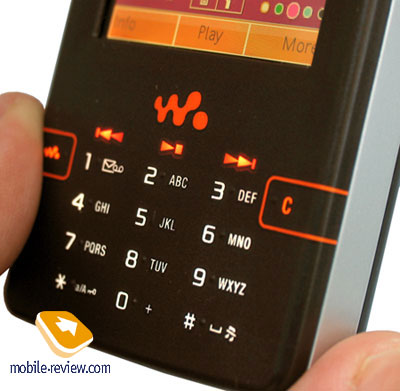
After all, the N91 got three votes; the rest went to the W950i – two votes. But the participants highlighted presence of the touchscreen and all the benefits the user gains from having it around. Thus both devices earn “+”.

Audio jack
The designers of the N91 applied standard miniUSB-socket for data transfer purposes and a 3,5 mm audio jack for headphones, whereas the developers of the W950i picked a different route and equipped their handset with a proprietary Fast Port slot, so that whether you are going to upload new tracks or just listen to music, you will have to turn to the company’s own headsets and cables, which is an obvious omission. On the other hand, the W950i is compatible with all native accessories, which is a major plus. Nonetheless, the member of the focus-group gave it to Nokia N91. The W950i ends up with another “-“.


Battery life
Basing on the data quoted in the reviews and the results I got during the quality time with the devices, I can conclude the following. Nokia N91 with enabled cellular module can play back music for about 10 hours straight, but the W950i easily outdoes it with its 13.5 hours. In practice this difference is especially striking: a “heavy” user (1,5-2 hours of calls a day, 2-3 hours of music playback, mail checks, a bit of web surfing) can squeeze around one day out of the N91, whereas the W950i can keep itself up and running even at such load for two days. Thus the “+” goes to the W950i, and the “-“ – to the N91.
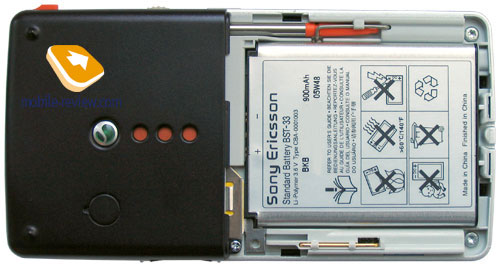

Music transfer
Both handsets come bundled with data cables, are able to work in Mass Storage, and have the software for transferring music boxed with them (for Sony Ericsson it is Disk2Phone, for Nokia N91 – Nokia Music Manager). Dwelling upon these apps won’t make much sense, since vast majority of users copy music from disks via other applications, and then upload it onto the phone via that old and unoriginal trick of Copy/Paste.
However the data transfer speed is what everything is about here. A 16,2-megabyte track is uploaded onto Nokia N91 in about 20 seconds, while the W950i receives it in 4-5 seconds. What a gap it is, right? Now imagine how long it will take to fill up the entire storage space with music – honestly, the W950i is way more pleasant to work with in this department. For this it gets a “+”, and Nokia N91, as a runner-up, scores a “-“.
Basic player implementation
The music libraries found on the N91 and W950i sport a bevy of settings, you can learn more about them in the reviews published on Mobile-Review.com. In the case of Nokia N91 the idea of the media library is quite simple – no extras, pure functionality. This means that you can browse the list containing all tracks, filter songs by album, artist, composer, genre, view playlists (you can create more than one of your own) and search files by first letters. The track currently playing can be quickly assigned as a ring tone. The following playback modes are at your disposal: repeat one song, all songs, shuffle. Also you can select the picture that will be displayed during playback.
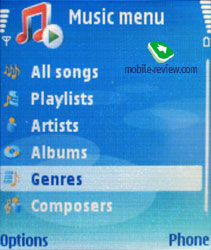 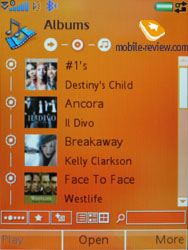
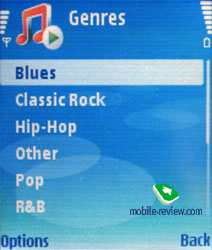 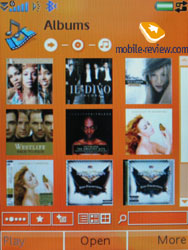
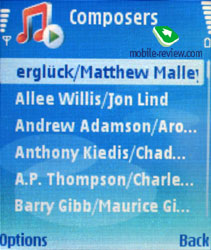 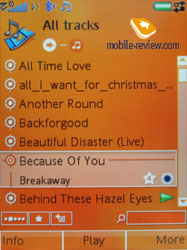
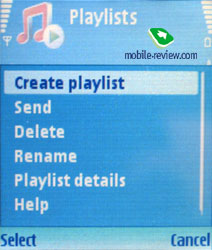 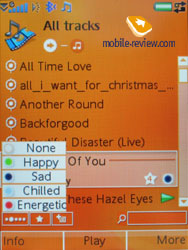
 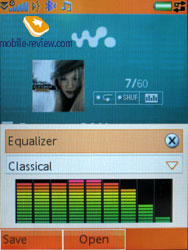
 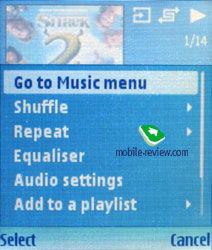
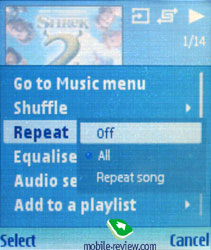 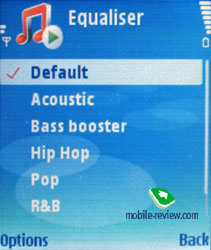
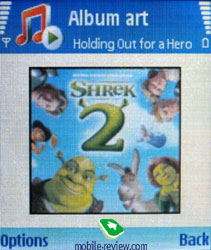
The W950i exposes somewhat different philosophy: you can sort tracks by artists, albums, mood (should be set up for every track), view all songs, playlists, create automatic playlists by certain criteria (mood, personal rating). Also there is only Album Art feature available, while it looks good, it’s pretty hard to sort the music library on the PC in a way to make this work effectively. During playback with a flick of an on-screen button you can set the mood for a track, rate it, enable Repeat and Shuffle. Any song can be assigned not only as a ring tone, but as the alarm clock tune, or beamed to another device by different means right from the player. Another thing of note is “fading” playback, when the player turns off automatically after some time (the most welcome feature for those fond of listening to music in bed), ability to set bookmarks (useful for people who listen to long mixes or audio books). On top of that you can change the player’s skin without modifying the theme.
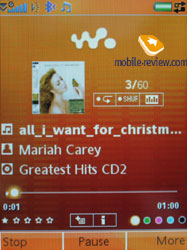 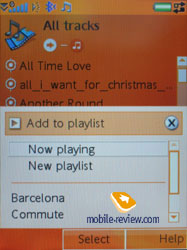

We could spend plenty of time telling about the W950i player’s merits; functionality-wise it is superior to that of the N91. Though, it’s clear that not everyone will put it to its limits in this department, but this isn’t the subject of thigh review, right? The focus-group declared the following: the W950i has got a better player onboard and deserves a “+”, while for a worse player implementation the N91 gets a “-“.
Sound quality
Another very subjective parameter, so the presence of a focus-group was very essential here. Personally, I find the sonic experience I get with the N91 far ahead of that of the W950i in just about every way – from volume to reproduction of high and low frequencies, solid basses and so on. On the other hand, the soft sounding of the W950i will perfectly fit some genres (classical music, for example). We tested the sound quality in the following way: offered the member of the focus group to listen to a handful of tracks (electronic, jazz, rock, pop) in identical headphones, Sony MDR-EX71, with the device hidden in a drawer.
Before revealing the outcome of the test, we are ought to mention some delicate aspects. Nokia N91 can deal with these formats: MP3, AAC, AAC+, eAAC+, Real, WAV, WMA, M4A, AMR-WB, True Tones, AMR-NB. While SE W950i supports MP3, AAC, AAC+, E-AAC+, WAV, m4a. As you see the number of formats available with the W950i is smaller, yet in real-world situations it is not vital, for many users prefer keeping their music in MP3 or WMA (and sometimes WAV).
A few words about the sound settings in these two handsets. In Nokia N91 the user can take advantage of the equalizer coming included with six presets (Acoustic, Bass Booster, Hip Hop, Pop, R&B, Rock) and default mode, also nothing prevents you from playing around with the equalizer to make up your own mode. The focus-group members noted that the equalizers don’t have any significant impact upon the sounding, thus the default settings are still the best choice. But in return the Stereo Widening, as well as the Loudness effect bring something new to the way the N91 sounds, however to me it’s more of a psychological factor, since I doubt they would have noticed it if I hadn’t said them about it. Balance adjustment was not appreciated by the focus-group member, or, better to day, they rated it as a useless feature.
The W950i works pretty much in the same manner: ten presets (including Mega Bass) and the default mode, the user is cut off manual equalizer management, but this isn’t something most would crave for. The members of the focus group appreciated the “Loudness” equalizer – as they say, it is the only way to go, since other settings aren’t that interesting. For example Mega Bass improves the basses, but at full blast the player can’t cope with such powerful basses and starts creaking etc. A remarkable aspect: the items stored in the N91 outside the equalizer menu (stereo widening, and Loudness) could have been moved to the same place where Sony Ericsson W950i has them. Really, the W950i doesn’t sport stand-alone menu items such as “Loudness” or “Mega Bass”
In the sense of subtle settings these models are evenly matched – the available sound settings will never leave you bored with default sounding, at that either of the handsets can brag about some exclusive add-ons to the traditional equalizers. The same goes for the supported formats – you will have everything you need with either of the phones (though I would really love .ogg support), including any-bitrate-enabled mp3’s
So, who came out on top in our test?
| Device |
Jazz
Lui Armstrong, Hello, Dooly |
Rock music
Rammstein, Bensin |
Pop music
Madonna, Secret |
Classical music
Richard Wagner |
Electronic
Armand Van Helden, You don`t know me |
| Nokia N91 |
+ |
+ |
- |
- |
+ |
| SE W950i |
- |
- |
+ |
+ |
- |
| Total |
«+» - 4
«-» - 1 |
«+» - 5 |
«+» - 3
«-» - 2 |
«+» - 2
«-» - 3 |
«+» - 4
«-» - 1 |
Make a note that the tests were carried out at full volume for the W950i and at 80-85% for the N91, otherwise facing these two handsets off would have been really hard. From my perspective, in terms of their music departments the two phones are like apples and oranges with Nokia N91 coming out on top in just about every way. And it is more likely that for now this handset in second to none on the market.
So, a “+” to Nokia N91 and a “-“ to SE W950i.
Radio
Details on radio modules embedded in the devices can be found in the respective reviews, so going over the same thing again is not necessary. The members of the focus-group gave it all to the W950i’s implementation due to the following cutting edges:
- Availability of a unique feature – TrackId, which works out not for any song around, yet is very interesting and pleasant.
- Auto-save of radio stations is done better than on Nokia N91 – from faster search to presence of advanced settings, including those for RDS.
- Strange it might sound, but handling radio with the W950i goes much easier than with the N91, at least four out of five testers insisted on this.
In result, the W950i receives a “+”, and the N91 puts a “-“ into its bank.
Other multimedia features
The foremost advantage of the N91 – presence of a 2 MPix camera, albeit its implementation leaves much to be desired. Also the model’s not-that-great screen lets it down, therefore viewing photos and watching videos is not much of a pleasure. Though all members of the focus-group had no doubts about the camera being the handset’s attraction – at the end of the day music-heavy devices are used mainly by youth and this audience craves after imaging capabilities. The W950i lacks a camera, yet houses a brilliant display that is a great help for its being multimedia-savvy offering – browsing photos, watching videos, reading books – it all feels great with the W950i.
But, a camera is a substantial factor, so Nokia N91 comes out of this contest with a “+” and SE W950i – with a “-“.
Wrapping it all up
For starters, let’s take a look at the summary table:
| Parameters |
Nokia N91 |
SE W950i |
| Sales package |
+ |
+ |
| Extra music accessories |
- |
+ |
| Bluetooth-headset support |
- |
+ |
| Remote control |
+ |
- |
| Design |
+ |
- |
| Weight, size |
- |
+ |
| Ergonomics and controls |
+ |
+ |
| Audio jack |
+ |
- |
| Battery life |
- |
+ |
| Music transfer |
- |
+ |
| Basic player implementation |
- |
+ |
| Audio quality |
+ |
- |
| Radio |
- |
+ |
| Other multimedia features |
+ |
- |
| Total |
7 |
9 |
To me the result turned out to be somewhat shocking – the W950i won by a marginal gap, yet a win is a win. Nevertheless I will allow myself a short note, so as to reassure our readers (and we would like to avoid criticism to some extent). Here is what this note is: if you are currently looking for a prime music handset, then both of the reviewed models should end up on our shortlist as either of them has got own merits. Over and above the pluses we listed annihilate the letdowns – for example I readily turn a blind eye to all shortcomings of my N91 for the great sonic experience it provides, design and materials used. Switching the parties, I can overlook pretty muffled sound output by the W950i, since it sports such a decent display, compact dimensions and a handful of tricks it has up its sleeve when it comes to radio and player applications. That is why I wouldn’t dare announce the champion here, in other words both devices have the upper hand against all the rest of solutions available on the market – in fact, there hasn’t been any offerings that could match these two, and I don’t count the N91’s update for one.
For the time being average prices for the devices are: 580 USD for the N91 and 625 USD for the W950i (the cheapest prices I stumbled upon in retail stores in Moscow). But in general it looks the following way: the W950i is about 10 percent more expensive than the N91 and will not give up on this trend until both devices get replaced.
Related links:
Sergey Kuzmin (skuzmin@mobile-review.com)
Translated by Oleg Kononosov (oleg.kononosov@mobile-review.com)
Published — 15 March 2007
Have something to add?! Write us... eldar@mobile-review.com
|
News:
[ 31-07 16:21 ]Sir Jony Ive: Apple Isn't In It For The Money
[ 31-07 13:34 ]Video: Nokia Designer Interviews
[ 31-07 13:10 ]RIM To Layoff 3,000 More Employees
[ 30-07 20:59 ]Video: iPhone 5 Housing Shown Off
[ 30-07 19:12 ]Android Fortunes Decline In U.S.
[ 25-07 16:18 ]Why Apple Is Suing Samsung?
[ 25-07 15:53 ]A Few Choice Quotes About Apple ... By Samsung
[ 23-07 20:25 ]Russian iOS Hacker Calls It A Day
[ 23-07 17:40 ]Video: It's Still Not Out, But Galaxy Note 10.1 Gets An Ad
[ 19-07 19:10 ]Another Loss For Nokia: $1 Billion Down In Q2
[ 19-07 17:22 ]British Judge Orders Apple To Run Ads Saying Samsung Did Not Copy Them
[ 19-07 16:57 ]iPhone 5 To Feature Nano-SIM Cards
[ 18-07 14:20 ]What The iPad Could Have Looked Like ...
[ 18-07 13:25 ]App Store Hack Is Still Going Strong Despite Apple's Best Efforts
[ 13-07 12:34 ]Infographic: The (Hypothetical) Sale Of RIM
[ 13-07 11:10 ]Video: iPhone Hacker Makes In-App Purchases Free
[ 12-07 19:50 ]iPhone 5 Images Leak Again
[ 12-07 17:51 ]Android Takes 50%+ Of U.S. And Europe
[ 11-07 16:02 ]Apple Involved In 60% Of Patent Suits
[ 11-07 13:14 ]Video: Kindle Fire Gets A Jelly Bean
Subscribe
|











































